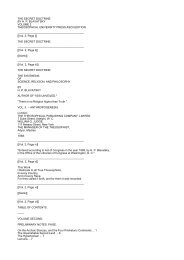You also want an ePaper? Increase the reach of your titles
YUMPU automatically turns print PDFs into web optimized ePapers that Google loves.
Plate IV.<br />
in outline; but it is sometimes traced in red ink (No. 7915), or in gold (No. 15,518). Incuse hieroglyphics<br />
are sometimes filled with gold (No. 7881). The name <strong>of</strong> <strong>the</strong> person with whom <strong>the</strong> scarab was buried<br />
usually precedes <strong>the</strong> text <strong>of</strong> <strong>the</strong> Chapter <strong>of</strong> <strong>the</strong> Heart; but in many instances blank spaces are found left<br />
without insertion <strong>of</strong> <strong>the</strong> name--a pro<strong>of</strong> that i, <strong>the</strong>se amulets were bought ready-made. The base however<br />
is <strong>of</strong>ten quite plan (Nos. 7965, 7966), or figures <strong>of</strong> Osiris, Isis, and Nephthys occupy <strong>the</strong> place <strong>of</strong> <strong>the</strong><br />
usual inscription (Nos. 15,500, 15,507). The backs <strong>of</strong> scarabs are generally quite plain, but we find<br />
examples inscribed with figures <strong>of</strong> <strong>the</strong> boat <strong>of</strong> <strong>the</strong> Sun Osiris, with flail and crook <strong>the</strong> bennu bird, and <strong>the</strong><br />
u'tat (No. 7883), Ra and Osiris (No. 15,507), and <strong>the</strong> bennu bird with <strong>the</strong> inscription neteri ab en Ra, "<strong>the</strong><br />
mighty heart <strong>of</strong> Ra" (No. 7878). A finehard, green stone scarab <strong>of</strong> <strong>the</strong> Greek or Roman period has upon<br />
<strong>the</strong> back <strong>the</strong> figures <strong>of</strong> four Greek deities (No. 7966). In rare instances, <strong>the</strong> beetles have a human face<br />
(Nos. 7876, 15,516) or head (No. 7999). Carefully made scarabs have usually a band <strong>of</strong> gold across and<br />
down <strong>the</strong> back where <strong>the</strong> wings join: an example <strong>of</strong> <strong>the</strong> late period (No. 7977) has <strong>the</strong> whole <strong>of</strong> <strong>the</strong> back<br />
gilded. The scarab was set in a gold oval ring, at one end <strong>of</strong> which was a smaller ring for suspension<br />
from <strong>the</strong> neck or for attachment to <strong>the</strong> bandages <strong>of</strong> <strong>the</strong> mummy (No. 15,504). The green glazed faïence<br />
scarab <strong>of</strong> Thothmes III. (No. 18,190) was suspended by a gold chain from a bronze torque. A thick gold<br />
wire to fit <strong>the</strong> neck is attached to No. 24,401. The base <strong>of</strong> <strong>the</strong> scarab is sometimes in <strong>the</strong> form <strong>of</strong> a heart<br />
(Nos. 7917, 7925). A remarkable example <strong>of</strong> this variety is No. 7925, in which are<br />
[1. The fifth king <strong>of</strong> <strong>the</strong> IVth dynasty.<br />
2. This prince is said to have been a very learned man, whose speech was difficult to be understood (see Wiedemann, Aeg.<br />
Geschichte., p. 191).<br />
3. For <strong>the</strong> hieroglyphic text, see pp. 13-15. This rubric was published by Birch, Aeg. Zeitschrift, p. 54; and by Rosellini,<br />
Breve Notizia interno un frammento di Papiro funebre Egizio essistente nel ducale museo di Parma; Parma, 1839, 8vo.]<br />
{p. 263}<br />
<strong>the</strong> emblems <strong>of</strong> "life," "stability," and "protection," engraved on <strong>the</strong> upper part <strong>of</strong> <strong>the</strong> base. Across <strong>the</strong><br />
back <strong>of</strong> this scarab is -- ###;[1] On <strong>the</strong> right wing:-- ### and on <strong>the</strong> left ###[2]. A highly polished, fine<br />
green basalt scarab with human face (No. 7876) is set in a gold base, upon <strong>the</strong> face and edges <strong>of</strong> which<br />
are cut part <strong>of</strong> <strong>the</strong> Chapter <strong>of</strong> <strong>the</strong> Heart. At a period subsequent to <strong>the</strong> XXIInd dynasty inscribed funereal<br />
scarabs in marble, paste, etc., were set in pylon-shaped pectorals made <strong>of</strong> Egyptian porcelain, glazed<br />
blue, green, or yellow, which were sewed to <strong>the</strong> mummy bandages over <strong>the</strong> heart. On such pectorals <strong>the</strong><br />
boat <strong>of</strong> <strong>the</strong> Sun is ei<strong>the</strong>r traced in colours or worked in relief, and <strong>the</strong> scarab is placed so as to appear to<br />
be carried in <strong>the</strong> boat; on <strong>the</strong> left stands Isis, and on <strong>the</strong> right Nephthys (Nos. 7857, 7864, 7866).<br />
Next: Plates V. and VI.<br />
http://www.sacred-texts.com/egy/ebod/ebod16.htm (4 <strong>of</strong> 4) [8/10/2001 11:25:24 AM]

















